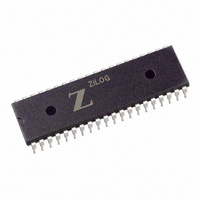Z85C3010PSG Zilog, Z85C3010PSG Datasheet - Page 237

Z85C3010PSG
Manufacturer Part Number
Z85C3010PSG
Description
IC 10MHZ Z8500 CMOS SCC 40-DIP
Manufacturer
Zilog
Series
SCCr
Specifications of Z85C3010PSG
Processor Type
Z80
Features
Error Detection and Multiprotocol Support
Speed
10MHz
Voltage
5V
Mounting Type
Through Hole
Package / Case
40-DIP (0.620", 15.75mm)
Cpu Speed
8MHz
Digital Ic Case Style
DIP
No. Of Pins
40
Supply Voltage Range
5V
Operating Temperature Range
0°C To +70°C
Svhc
No SVHC (18-Jun-2010)
Base Number
85
Rohs Compliant
Yes
Clock Frequency
10MHz
Lead Free Status / RoHS Status
Lead free / RoHS Compliant
Other names
269-3934
Z85C3010PSG
Z85C3010PSG
Available stocks
Company
Part Number
Manufacturer
Quantity
Price
Company:
Part Number:
Z85C3010PSG
Manufacturer:
Zilog
Quantity:
135
Company:
Part Number:
Z85C3010PSG
Manufacturer:
Zilog
Quantity:
326
- Current page: 237 of 317
- Download datasheet (4Mb)
Application Note
Serial Communication Controller (SCC
THE SDLC LOOP MODE
The SDLC Loop mode is one of the protocols used in the
ring configuration network topology. The typical network
configuration is shown in Figure 5. As shown, there is one
Master (or primary) station and several slave (or
secondary) stations. This figure does not have a clock
This mode is similar to the normal SDLC mode, other than
that secondary stations are not allowed to freely send out
packets. When a secondary station wants to send a
packet, it needs to wait for a special pattern to be received.
The pattern is called EOP (End Of Poll), and consists of a
0 followed by seven 1s on the transmission line (as data, it
is 11111110). This pattern resembles the SDLC Flag
pattern (7EH; 0111110), except the last bit has been
changed to a 1 thus turning this pattern into a flag.
Upon network initialization, secondary station TxD and
RxD connections use gate propagation delay. On the first
EOP, a secondary station inserts one bit -time delay
between RxD and TxD, and relays RxD input to TxD.
6-102
Slave SCC #1
Rx
Tx
Figure 5. SDLC Loop Mode Configuration
™
): SDLC Mode of Operation
Slave SCC #2
Rx
Master SCC
Tx
connection, but each station’s transmit clock must be
synchronized to the master SCC. This can be done by
feeding the clock using a separate clock line, or by using
Phase Locked Loop (PLL) to recover the clock.
When it has a message to send out, it waits for an EOP.
When it detects EOP in this phase, it changes the last bit
of the EOP to zero, making it a Flag, then begins to send
its own message. From this point on, normal SDLC
transmission modes apply. Packets conclude with Mark
idle, identifying it as an EOP pattern. The secondary
station then reverts back to one bit delay mode.
Figure 6 illustrates this mode’s sequence of events. To
simplify the example, this figure assumes there is one
Master station and one Slave station. If there are more
Slave stations, there will be additional one bit time delay
per station after the network has initialized for loop mode
of operation.
Rx
Tx
Slave SCC #n
Rx
Tx
UM010901-0601
Related parts for Z85C3010PSG
Image
Part Number
Description
Manufacturer
Datasheet
Request
R

Part Number:
Description:
Manufacturer:
Zilog, Inc.
Datasheet:

Part Number:
Description:
Cmos Scc Serial Communications Controller
Manufacturer:
ZiLOG Semiconductor
Datasheet:

Part Number:
Description:
Communication Controllers, ZILOG INTELLIGENT PERIPHERAL CONTROLLER (ZIP)
Manufacturer:
Zilog, Inc.
Datasheet:

Part Number:
Description:
KIT DEV FOR Z8 ENCORE 16K TO 64K
Manufacturer:
Zilog
Datasheet:

Part Number:
Description:
KIT DEV Z8 ENCORE XP 28-PIN
Manufacturer:
Zilog
Datasheet:

Part Number:
Description:
DEV KIT FOR Z8 ENCORE 8K/4K
Manufacturer:
Zilog
Datasheet:

Part Number:
Description:
KIT DEV Z8 ENCORE XP 28-PIN
Manufacturer:
Zilog
Datasheet:

Part Number:
Description:
DEV KIT FOR Z8 ENCORE 4K TO 8K
Manufacturer:
Zilog
Datasheet:

Part Number:
Description:
CMOS Z8 microcontroller. ROM 16 Kbytes, RAM 256 bytes, speed 16 MHz, 32 lines I/O, 3.0V to 5.5V
Manufacturer:
Zilog, Inc.
Datasheet:

Part Number:
Description:
Low-cost microcontroller. 512 bytes ROM, 61 bytes RAM, 8 MHz
Manufacturer:
Zilog, Inc.
Datasheet:

Part Number:
Description:
Z8 4K OTP Microcontroller
Manufacturer:
Zilog, Inc.
Datasheet:

Part Number:
Description:
CMOS SUPER8 ROMLESS MCU
Manufacturer:
Zilog, Inc.
Datasheet:

Part Number:
Description:
SL1866 CMOSZ8 OTP Microcontroller
Manufacturer:
Zilog, Inc.
Datasheet:











